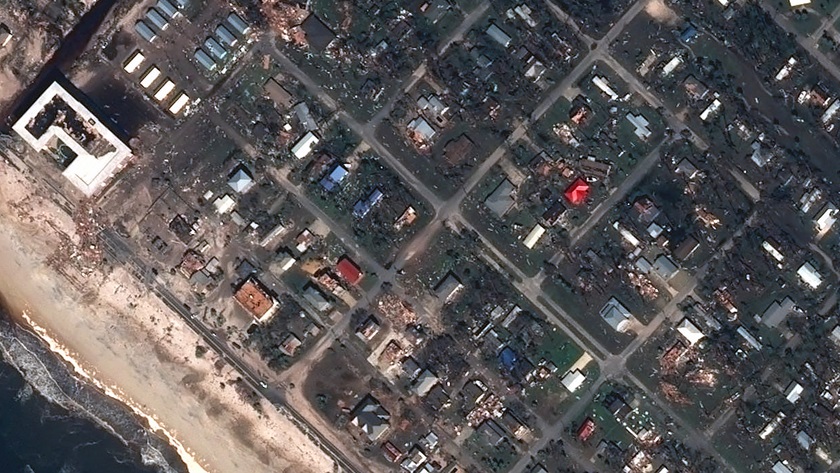Aviation active in relief efforts after Hurricane Michael
Electric power restoration was underway and urgent searches for people still missing in devastated Mexico Beach, Florida, continued in the aftermath of Hurricane Michael storming ashore in the Florida Panhandle on Oct. 10, and trailing destruction into the mid-Atlantic states.
As of the morning of Oct. 16, approximately 18 people were known to have died from hurricane-related causes, and 230,000 remained without power, down from about 400,000, according to news reports. Cell phone service was out in some areas for a fifth day.
Unlike the ultra-slow-moving Hurricane Florence that wreaked havoc in September after forming near the west coast of Africa, Hurricane Michael originated in the Caribbean and sped through Florida, Georgia, the Carolinas, and Virginia.
CNN reported long lines at gasoline stations and residents of hard-hit areas “relying on airdropped food and water to survive.”
Multiple temporary flight restrictions had been in effect in the Florida and Georgia storm zone as President Donald Trump and other officials inspected damaged areas on Oct 15. As of Oct. 16, a TFR remained in effect at Tyndall Air Force Base, east of Panama City, where 93 service members rode out the storm. The base sustained catastrophic damage, but can be rebuilt, said the military. AOPA urges pilots of manned and unmanned aircraft to check notices to airmen before conducting flights in storm-stricken areas.
Florida Gov. Rick Scott harnessed Twitter to inform residents of the progress of relief efforts, tweeting on Oct. 16, “At the @WakullaSheriff’s Office this morning talking to local officials about how their community was impacted by Hurricane Michael. We are 100% focused on response and recovery for FL families.”
In a previous tweet he suggested ways to help. “I’ve activated the FL disaster fund to help assist these communities as they recover. The easiest way to help is to donate- text the word DISASTER to 20222 to make a one-time donation of $10,” he tweeted.
Early images of the devastation came from Florida Civil Air Patrol pilots flying single-engine airplanes from Pensacola International Airport over Destin, Panama City, and Mexico Beach.
Operation Airdrop, the volunteer general aviation relief organization, also reported on relief efforts involving more than 100 GA aircraft, and suggested ways for donors to help.
“Not like North Carolina. Instead of water blocking the road, there are houses blocking the road,” the group said in an Oct. 16 Facebook post. Operation Airdrop, operating from a base at Florida’s Gainesville Regional Airport, also issued an appeal for help: “Gainesville! WE NEED VOLUNTEERS! We know we have supplies, and we have planes, now we need you! Skip the gym, get your workout here with us! Come on down to 4505 NE 40th Terrace, Gainesville, Florida, 32609.”
The organization announced joining forces with the Cajun Navy Foundation and World Hope International to offer disaster relief to the panhandle. “The collaborative effort will bring expedient aid to those affected via land, air and sea. In the face of time-sensitive needs and challenging terrain, the decision to combine resources will ensure the most efficient and effective support possible for the devastated areas,” they said.
In Albany, Georgia, utility crews put in long shifts to re-establish electric power, in some cases returning to their own powerless homes in the state’s southwest area. Georgia Power recorded restoration of power to 97 percent of its customers by Oct. 15, with 5,700 personnel working round-the-clock to get the electricity flowing again to those in the hardest-hit areas.
“All of Georgia Power’s resources are dedicated to storm restoration efforts in the state, and the company continues to mobilize additional resources from assisting utilities as they become available,” the utility said.
As storm impact evaluation proceeded, images provided by Airbus Aerial, an Atlanta-based data-gathering system that combines Airbus’s constellation of high-resolution satellites and fleets of unmanned aircraft, were helping organizations that support recovery operations focus their efforts.
According to a news release, Airbus Aerial “can collect, analyze and deliver actionable data from a range of 100 feet off the ground all the way up into the troposphere by utilizing a number of assets including drones, helicopters, satellites and more,” and has positioned teams on the ground in affected areas.

Shoreline devastation in Mexico Beach, Florida. Photo courtesy of Airbus Aerial.




